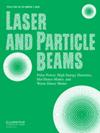Study on Gain Regularity of High Power Microwave Obtained by Using Path Encoding Pulse Compression
IF 1.9
4区 物理与天体物理
Q4 PHYSICS, APPLIED
引用次数: 0
Abstract
This study is the further research of the path encoding pulse compression technique. In this study, the regularity of pulse compression gain is studied by adopting the numerical simulation and experiment measurement methods. For the lossless cavity, the power gain has the characteristic of equal pulse length with equal compression gain contribution according to the numerical simulation results. It means that the pulse compression gain is increased linearly along with the time length of the input pulse. The obtained pulse power gains are equal for the two subpulses intercepted arbitrarily form the input pulse with equal time length for the pulse compression. For the lossy cavity, the power gain usually does not increase significantly after the length of input pulse reaches to a certain value. The gain contribution decreases gradually along with the increase of time length of input pulse until the growth rate of gain contribution equals to zero. Assuming two subpulses with equal time length were intercepted from the input pulse, the gain contribution of the earlier subpulse is lower than that of the later subpulse. The measured results verified the simulated gain contribution regularity according to the established experimental system.利用路径编码脉冲压缩获得高功率微波增益规律的研究
本研究是对路径编码脉冲压缩技术的进一步研究。本文采用数值模拟和实验测量相结合的方法,研究了脉冲压缩增益的规律。数值模拟结果表明,对于无损腔体,功率增益具有等脉冲长度和等压缩增益贡献的特性。这意味着脉冲压缩增益随输入脉冲的时间长度线性增加。任意截取的两个子脉冲形成等时间长度的脉冲压缩输入脉冲,所获得的脉冲功率增益相等。对于损耗腔,在输入脉冲长度达到一定值后,功率增益通常不会显著增加。增益贡献随着输入脉冲时间长度的增加逐渐减小,直到增益贡献的增长率为零。假设从输入脉冲中截取两个时间长度相等的子脉冲,则前一个子脉冲的增益贡献小于后一个子脉冲的增益贡献。实测结果验证了根据所建立的实验系统所模拟的增益贡献规律。
本文章由计算机程序翻译,如有差异,请以英文原文为准。
求助全文
约1分钟内获得全文
求助全文
来源期刊

Laser and Particle Beams
PHYSICS, APPLIED-
CiteScore
1.90
自引率
11.10%
发文量
25
审稿时长
1 months
期刊介绍:
Laser and Particle Beams is an international journal which deals with basic physics issues of intense laser and particle beams, and the interaction of these beams with matter. Research on pulse power technology associated with beam generation is also of strong interest. Subjects covered include the physics of high energy densities; non-LTE phenomena; hot dense matter and related atomic, plasma and hydrodynamic physics and astrophysics; intense sources of coherent radiation; high current particle accelerators; beam-wave interaction; and pulsed power technology.
 求助内容:
求助内容: 应助结果提醒方式:
应助结果提醒方式:


